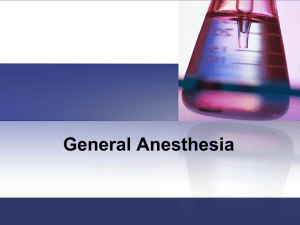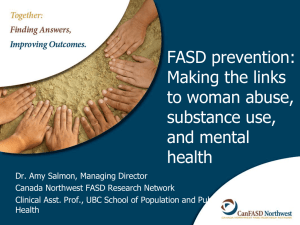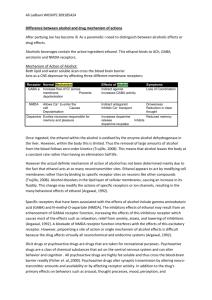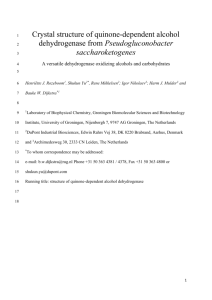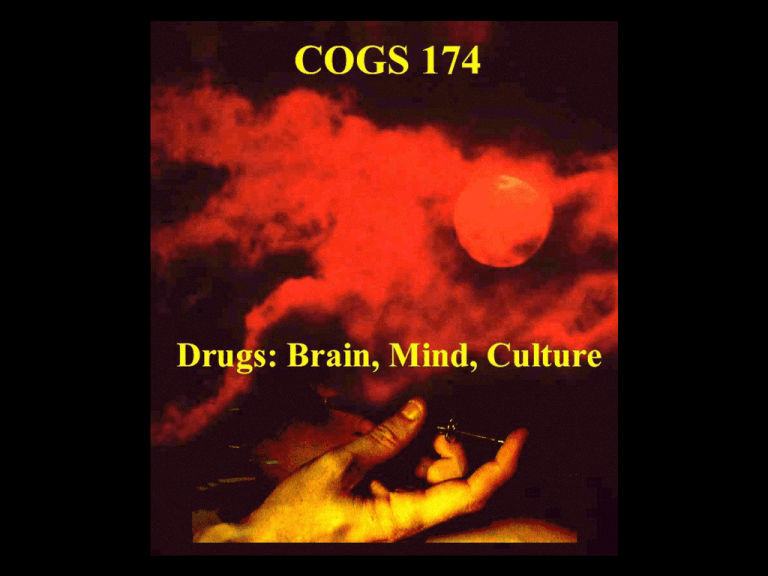
Alcohol/Ethanol (ethyl alcohol)
NHSDA 2000 Alcohol Use Statistics
(National Household Survey on Drug Abuse)
• “Drink” = can or bottle of beer, glass of wine or a wine
cooler, shot of liquor, or mixed drink with liquor in it.
• Current use - At least one drink in the past 30 days
(includes binge and heavy use).
• Binge use - Five or more drinks on the same occasion at
least once in the 30 days prior to survey (includes heavy
use).
• Heavy use - Five or more drinks on the same occasion at
least five different days in the past 30 days.
What is equal to what?
12 oz Beer = 4 oz Wine = 1 oz Liquor
=
=
Calculating BALs
• BALs are given in milligrams (mg) per 100
milliliters (ml) of whole blood
• Convert weight (e.g., 100 lbs) to kilograms by
dividing by 2.2 (1 kg = 2.2 lb)
• This weight is adjusted because not all of the
body is capable of absorbing alcohol (75% in men
and 66% in women)
• Convert alcohol to milligrams
• Divide the mg of alcohol/ml of body fluid x 100
• The effects of Alcohol vary depending on many
factors
– Previous experience
– Amount consumed in a given time period
– Drinker's size, body build, and metabolism
– Type and amount of food in the stomach
– Gender
Statistics
– About half of Americans ages 12 and older report drinking alcohol.
– About 3 in 10 (30 percent) American adults drink at levels that
increase their risk for physical, emotional, and social problems.
– Of these heavy drinkers, about 1 in 4 currently has an alcohol
abuse or dependence disorder.
– Alcohol is the leading cause of death among teenagers, because of
traffic fatalities
• 16 % of teenagers have had “blackouts”
– Teenagers who start drinking before age 15 are FOUR times as
likely to become alcohol dependent as those who begin at age 21
Incidence by Gender and Age
• More men report being current drinkers than do
women.
• The rate of alcohol dependence is also lower for
women than for men.
• The incidence of heavy alcohol use is highest
among young adults between ages 21 and 29.
• The incidence of alcohol problems is lowest
among adults ages 65 and older.
Positive Effects of Moderate Doses
(1-2 drinks/day)
• Pleasurable
• Anxiolytic (relieves anxiety and
depression)
• Increases socialization (“the
social lubricant”)
• Lowers mortality rate relative to
non-drinkers
– probably due to elevating HDL
(“good” cholesterol)
• Increases levels of estrogen
(easing postmenopausal
symptoms)
Expectancies and Advertisement
• Many “positive” effects of
alcohol are expectancy-based
– Sociability
– Attractiveness
– Sexual prowess
– Etc.
• Where do alcohol expectancies
come from?
Negative Effects of High-level Consumption
• Reduced sex drive
• Shrinking brain, enlarged
ventricles
• High blood pressure
• Cirrhosis of the liver
• Peripheral Neuropathy
• Korsakoff’s Syndrome
• Depression
• Decreased brain glucose
metabolism
Negative Effects continued
• Cerebellar degeneration
• Increased risk of stroke
• Muscle inflammation and
atrophy
• Men: testicular atrophy,
decreased sperm and testosterone
production, impotence
• Women: menstrual irregularities
• Addiction
Fetal Alcohol Spectrum Disorders
• The most serious risk during pregnancy is fetal alcohol
spectrum disorders (FASD).
• FASD is the leading known cause of mental retardation in
the United States.
Fetal Alcohol Spectrum Disorders
A. Magnetic resonance imaging showing the side view of a 14-year-old control subject with a normal corpus callosum; B. 12year-old with FAS and a thin corpus callosum; C. 14-year-old with FAS and agenesis (absence due to abnormal development) of
the corpus callosum.
Source: Mattson, S.N.; Jernigan, T.L.; and Riley, E.P. 1994. MRI and prenatal alcohol exposure: Images provide insight into
FAS. Alcohol Health & Research World 18(1):49–52.
Cause of FASD
• The sole cause of FASD is women drinking
alcoholic beverages during pregnancy.
• Alcohol is a teratogen (something that interferes
with development of fetus)
“Of all the substances of abuse (including cocaine,
heroin, and marijuana), alcohol produces by far the
most serious neurobehavioral effects in the fetus.”
—IOM Report to Congress, 1996
Acute Cognitive Impairments
White et al., 1998
• Memory formation
• Attention (divided, selective)
• Reaction time
• Visual search and tracking
• Abstract thinking
• Problem solving/flexibility
• Multi-tasking
• “Alcohol myopia”
• Impaired judgement of abilities
• Flattened P300
Typical examples of P300
Normal
Alcoholic
Karaaslan et al., 1999
Tapert et al., 2001
Non-drinkers
Alcoholics
18-25 year olds performing a nonverbal working memory test
Pharmacokinetics
• Both water soluble and lipid soluble
• Absorbed through lining of digestive tract
• Follows zero-order kinetics for elimination
• 5-15% excreted unmetabolized through exhaled breath,
sweat, urine
• 85-95% metabolized in liver
• build up of acetaldehyde leads to “flushing response”
Ethanol
Acetaldehyde
Alcohol
Dehydrogenase
Acetate
Aldehyde
Dehydrogenase
Pharmacokinetics (cont)
• Another system of alcohol metabolism: microsomal ethanol-oxidizing
system (MEOS) – involved in the metabolism of barbiturates.
– Alcohol dehydrogenase saturates at low to moderate BACs (MichaelisMenten kinetics)
– Apparent zero-order kinetics at moderate BACs
• Alcohol Elimination Rate = 7 g per hr
• Disappearance Rate = 0.015% per hr
• Histamine receptor antagonists (e.g., Tagmet and Zantac), typically
used to reduce stomach acidity, also reduce levels of alcohol
dehydrogenase, increasing BAL.
• Women have lower levels of alcohol dehydrogenase
• Some Asians have a malfunctioning aldehyde dehydrogenase enzyme
Old Pharmacodynamic View
• Lipid Perturbation Hypothesis (Meyer, 1901)
– Alcohol disturbs cell membrane integrity
– Leaky cells allow chemicals in more easily
– Widespread non-specific effects
• Alcohol does do this, but so do things like a slight change
in temperature (i.e., fevers)
• More specific effects on receptors…
Acute Pharmacodynamics
• Indirect agonist at GABAa receptor
• Inverse agonist at NMDA receptor
• Facilitates DA, 5-HT neurotransmission
• Increases DA levels in NAc, via some indirect GABAa
effect
Ro15-4513, a GABAa
antagonist (indirect for
GABA, direct for alcohol)
reverses alcohol intoxication
Alcohol and the GABA Receptor
• When alcohol enters the brain, it binds to GABA
receptors and amplifies the hyperpolarization
effect of GABA.
• The neuron activity is further diminished
• This accounts for some
of the sedative affects
of alcohol
science.howstuffworks.com/ alcohol.htm
Alcohol and Dopamine
Alcohol and Nicotine
Chronic Pharmacodynamics
(adaptive processes)
• Decreased GABAa receptor function
• Increased density of NMDA receptors
• Decreased DA function
• 5-HT dysfunction
Alcoholics are more sensitive
to stress than non-alcoholics
Blocking one receptor that
mediates stress, the
neurokinin 1 receptor (NK1R)
reduces the exaggerated
activation in areas of the brain
associated with negative
emotions.
The blocker also restored
activity in the pleasure centers
of the brain in response to
positive pictures.
Markus Heilig
Tolerance
• Behavior
– commonly half the level of behavioral intoxication at same blood
alcohol level of nontolerant individuals
– environment-dependent tolerance
– learned tolerance
• Pharmacokinetic Mechanism
– liver increases enzyme levels
– accounts for up to 25% of tolerance
• Pharmacodynamic mechanisms
– changes in NMDA and GABAa receptors as per chronic effects
Withdrawal
• Excitatory/inhibitory amino acid imbalance
– Hyperexcitability
– Seizures
• Delirium Tremens (DTs) - 5% of patients develop it and a 35% mortality
rate if untreated
– Rapid heart rate
– Increased body temperature
– Increased blood pressure
– Psychomotor agitation
movement
– Confusion
-
Tremors
Hallucinations
Sweating
Loss of ability to control muscle
- Increased blood pressure
– Cardiovascular collapse and death
– Disorientation
- altered mental status
– Sleep disorders
• Dysfunctional monoamine systems
– Depression
Pharmacotherapies
• Benzodiazepines
– For acute withdrawal
• Disulfiram (Antabuse)
– Interferes with alcohol metabolism
– Causes aversive reaction (like flushing response)
• Naltrexone
– Opioid antagonist
– Supposed to decrease craving
– Efficacy still under debate
Pharmacotherapies (cont.)
• Antidepressants
– Causal direction between alcoholism and depression unclear
– May treat underlying motivation to drink, or reduce depression as
withdrawal symptom
Family History Positive
• FHP: one or more first-degree alcoholic relatives
• 3-7x risk of alcoholism (esp. males)
• Increased response to pleasurable (and reinforcing?)
effects, decreased response to impairing effects
– May map onto periods of increasing vs. decreasing blood alcohol
level (BAL)
• Decreased cortisol (stress hormone) response
• Smaller decrease in P300 amplitude from acute alcohol


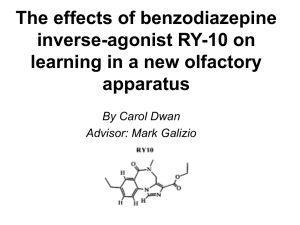
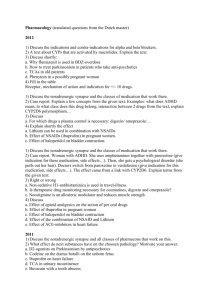
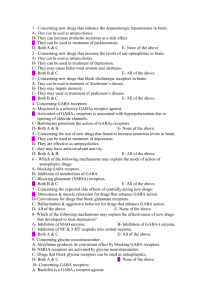
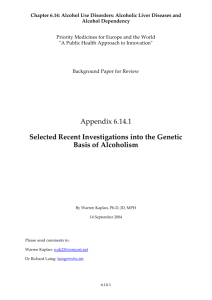
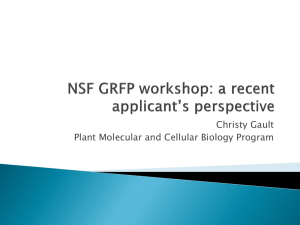
![Shark Electrosense: physiology and circuit model []](http://s2.studylib.net/store/data/005306781_1-34d5e86294a52e9275a69716495e2e51-300x300.png)
